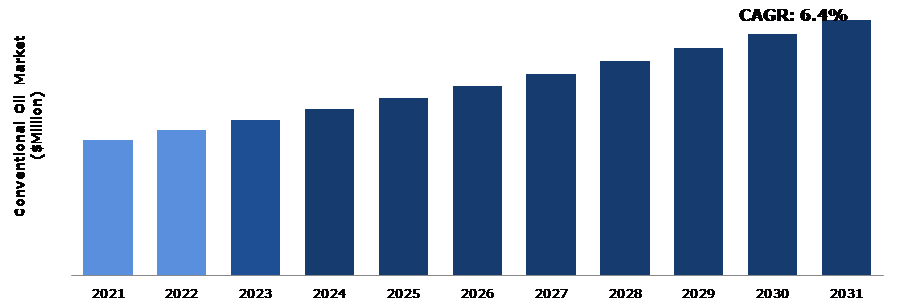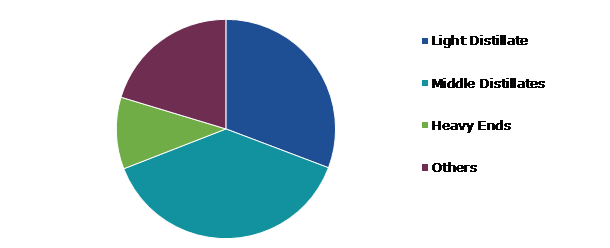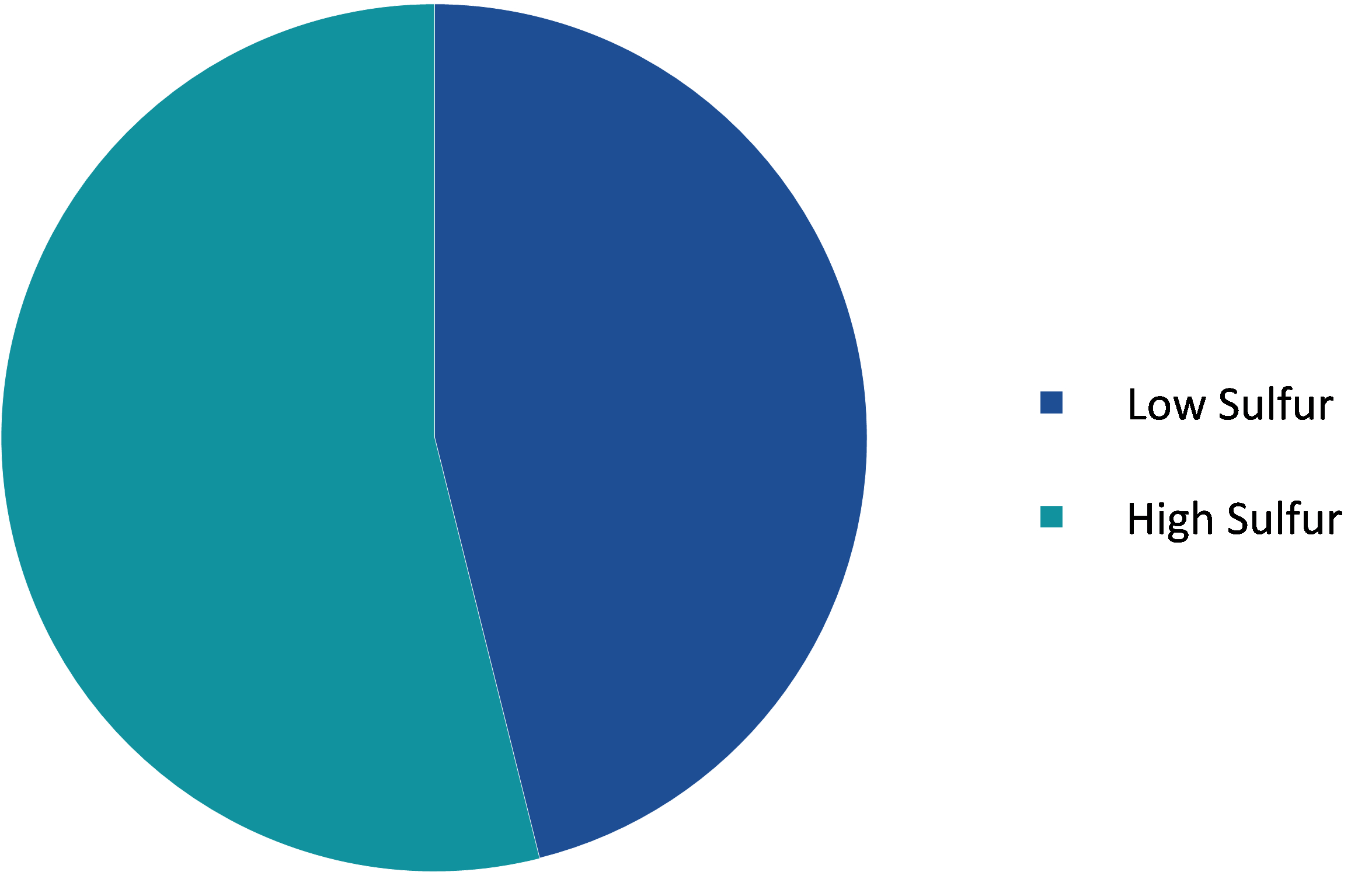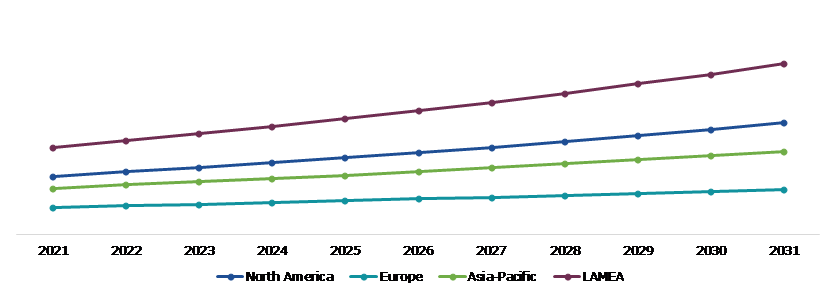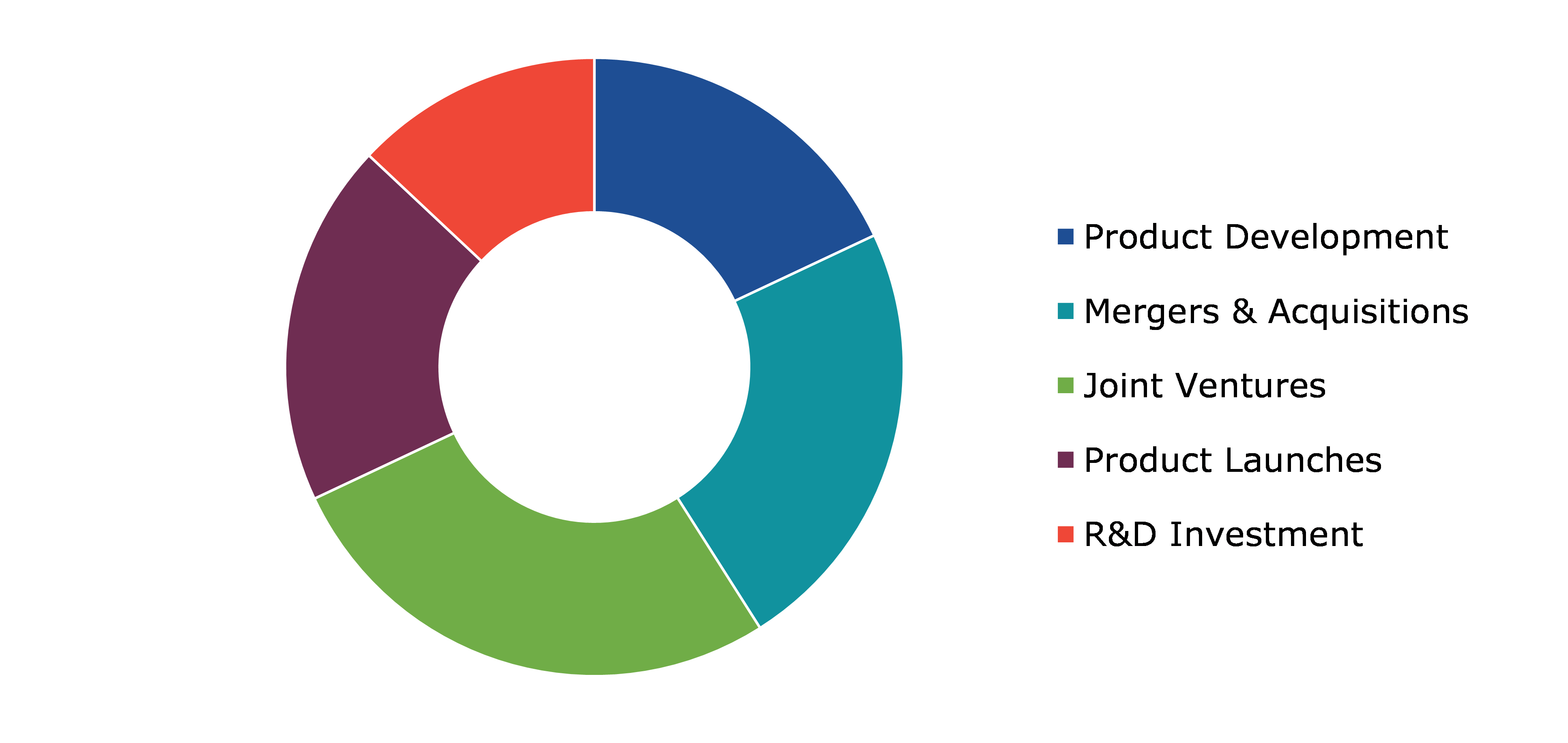Conventional Oil Market Report
RA08627
Conventional Oil Market by Type (Light Distillates, Middle Distillates, Heavy Ends, and Others), Sulfur Content (Low Sulfur and High Sulfur), End-user Industry (Automotive, Chemical, Power, Industrial, and Others), and Regional Analysis (North America, Europe, Asia-Pacific, and LAMEA): Global Opportunity Analysis and Industry Forecast, 2022-2031
Global Conventional Oil Market Analysis
The Global Conventional Oil Market Size was $2,494 billion in 2021 and is predicted to grow with a CAGR of 6.4%, by generating a revenue of $4,690.2 billion by 2031.
Global Conventional Oil Market Synopsis
Conventional oil, often known as crude oil or petroleum, is an organic material that has originated naturally within the earth's crust. Conventional oil deposits are the most accessible and least technically difficult to develop. Increase in the need for improved equipment reliability and uptime in various industries is expected to impact industrial oil sales in the upcoming years. Increase in production and sales of light-duty cars are expected to have a direct impact on engine oil consumption, driving demand for engine oil during the forecast period. Fossil fuels have been at the center of growth and trade ever since industrialization reorganized economies in order to manufacture goods. Fuels made from energy-dense crude oil have long since replaced coal in many applications and have dominated the transportation fuel market. These factors are expected to drive conventional oil market share expansion during the forecast period.
The frequency and size of changes in the price of conventional oil on a global scale have increased. The uncertainty brought on by fluctuations in oil prices is expected to slow down economic growth by raising production costs or altering investment behavior. All of these reasons are expected to hamper the growth of the conventional oil market revenue.
The increase in the use of cutting-edge technologies in the global market has emerged in the creation of sophisticated conventional oil-based engine oil. The development of superior engine oil for automotive applications is being aided by the rise in the usage of cutting-edge fuel and lubricant technology. These continuing innovations are anticipated to fuel market expansion during the forecast period.
According to regional analysis, the LAMEA conventional oil market accounted for the dominating market share in 2021. LAMEA conventional oil market is expected to expand as a result of the rise in automobile sales in Brazil, South Africa, and Saudi Arabia and the increase in demand for lower-viscosity motor oil supplements.
Conventional Oil Overview
Conventional oil petroleum reservoirs are often stratified, with numerous levels of varied reservoir quality. Conventional oil is an organic substance that formed naturally within the Earth's crust and is also referred to as crude oil or petroleum. It is a hydrocarbon, which means that its main ingredients are hydrogen and carbon with traces of other substances including nitrogen, sulfur, and different metals. Conventional oil is extracted from the earth through drilling and pumping.
COVID-19 Impact on Global Conventional Oil Market
The COVID-19 pandemic has brought several uncertainties leading to severe economic losses as various businesses across the world were standstill. In addition to posing a serious threat to human health, the global COVID-19 outbreak has also changed people's work and way of life. Countries implemented precautions like lockdowns to stop the disease from spreading as the number of confirmed cases increased. As a result of these measures, the world was subjected to an economic blockade, with global supply lines disrupted.
Increase in Demand for Conventional Oil as an Engine Oil to Drive Market Growth
Conventional oils are frequently the most cost-effective alternative because they require far less refinement and re-engineering, which can be costly processes. Many automakers still request conventional engine oils as long as they meet the most recent industry specifications. Importantly, while conventional motor oils are closer to natural oil than synthetics or half synthetics, they still contain key additives to assist decrease engine wear and increasing performance. Advanced conventional oils contain additives that can clear away existing sludge in oilways and prevent new sludge from accumulating. All these factors are anticipated to boost the conventional oil market share.
To know more about global conventional oil market drivers, get in touch with our analysts here.
Increase in the use of Synthetic Oil to Restrain the Market Growth
Conventional oil is effective at protecting the engine, but it does contain pollutants. Conventional oil is created by refining crude oil to give it the required characteristics for lubricating an engine. However, as it is derived from a natural process, conventional oil has some intrinsic irregularity in its structure at the molecular level. These contaminants may increase friction, hastening the oil's decomposition. Synthetic oil, on the other hand, is created from a wholly synthetic oil with a more regular molecular structure. Therefore, synthetic oil will last longer and perform better under harsh conditions. Due to all these factors, the market demand for conventional oil is expected to be hampered during the forecast years.
Increase in the use of Modern Technology in Conventional Oil to Drive Excellent Opportunities
Technological advancements will be essential in addressing global energy demand because they enable the discovery of new resources, access to harsh or isolated regions, and the development of difficult reservoirs, Technological developments allow for more oil and natural gas to be extracted from the length of each well, enhancing production and lowering the environmental impact of energy production. For example, by combining extended-reach drilling capacity with modern stimulation technology, oil companies may optimize how and where stimulation fluid interacts with rock, allowing sustained production rates along the length of the wellbore. These factors are estimated to create several opportunities for the key players operating in the market during the forecast period.
To know more about global conventional oil market opportunities, get in touch with our analysts here.
Global Conventional Oil Market, by Type
Based on type, the market has been divided into light distillate, middle distillates, heavy ends, and others. Among these, the middle distillates sub-segment accounted for the highest market share in 2021, whereas the light distillate sub-segment is estimated to show the fastest growth during the forecast period.
Global Conventional Oil Market Size, by Type, 2021
Source: Research Dive Analysis
The middle distillates sub-segment accounted for a dominant market share in 2021. Crude oil is one of the most precious commodities on the planet, but it is useless in its raw form. Middle distillates are largely utilized as fuel for heating, lighting, and transportation around the world. Middle distillates account for 25% to 40% of the oil product output during the refinement of crude oil. These are the major factors expected to drive the sub-segment growth during the forecast period.
Global Conventional Oil Market, by Sulfur Content
Based on sulfur content, the market has been divided into low sulfur and high sulfur. Among these, the high sulfur sub-segment accounted for the highest revenue share in 2021.
Global Conventional Oil Market Share, by Sulfur Content, 2021
Source: Research Dive Analysis
The high sulfur sub-segment accounted for a dominant market share in 2021. A common ingredient found in crude oil and petroleum products is sulfur. A crude oil grade with a high sulfur percentage will have a lower value on average. The high sulfur content of conventional oil is sometimes referred to as sour crude. It is suitable for use in all types of power plants, industries, industrial buildings, constructions, and boilers.
Global Conventional Oil Market, by End-user Industry
Based on end-user industry, the market has been divided into automotive, chemical, power, industrial, and others. Among these, the automotive sub-segment accounted for the highest revenue share in 2021.
Global Conventional Oil Market Growth, by End-user Industry, 2021
Source: Research Dive Analysis
The automotive sub-segment accounted for a dominant market share in 2021. Increase in automotive manufacturing and demand for traditional and synthetic materials are expected to drive growth. Automobile sales in Asia-Pacific and North America have been gradually expanding in recent years, owing mostly to population growth and an increase in consumer buying capacity. The market is predicted to develop significantly during the forecast period due to the high level of technological advancement implemented in the entire automotive sector.
Global Conventional Oil Market, Regional Insights
The conventional oil market was investigated across North America, Europe, Asia-Pacific, and LAMEA.
Global Conventional Oil Market Size & Forecast, by region, 2021-2031 ($ Million)
Source: Research Dive Analysis
The Market for Conventional Oil in LAMEA to be the Most Dominant
The LAMEA conventional oil market is anticipated to hold the highest market share in 2031. The LAMEA region, which includes five of the top ten oil-producing countries, accounts for around 27% of global oil output. The Middle East, the second most dynamic upstream market, has seen more than 30% expansion of refining capacity in recent years, and even more sizable global refining projects will be carried out there in the upcoming years. These investments are expected to have a beneficial influence on the market growth of the conventional oil market during the forecast period.
Competitive Scenario in the Global Conventional Oil Market
Investment and agreement are common strategies followed by major market players. For instance, in January 2023, UK-based oil giant BP intends to raise investments in its Texas and Gulf of Mexico oil and gas production assets. The decision comes in response to the U.S. government's plea to energy corporations to expand oil supplies in order to lower fuel prices as inflation expenses hit the industry.
Source: Research Dive Analysis
Some of the leading conventional oil market players are BP, Chevron, Eni, ExxonMobil, Shell, Total, CNPC, Equinor, Petrobras, and Repsol.
| Aspect | Particulars |
| Historical Market Estimations | 2020 |
| Base Year for Market Estimation | 2021 |
| Forecast Timeline for Market Projection | 2022-2031 |
| Geographical Scope | North America, Europe, Asia-Pacific, and LAMEA |
| Segmentation by Type |
|
| Segmentation by Sulfur Content |
|
| Segmentation by End-user Industry |
|
| Key Companies Profiled |
|
Q1. What is the size of the global conventional oil market?
A. The size of the global conventional oil market was over $2,494 billion in 2021 and is projected to reach $4,690.2 billion by 2031.
Q2. Which are the major companies in the conventional oil market?
A. BP, Chevron, and Eni are some of the key players in the global conventional oil market.
Q3. Which region, among others, possesses greater investment opportunities in the future?
A. The LAMEA region possesses great investment opportunities for investors in the future.
Q4. What will be the growth rate of the LAMEA conventional oil market?
A. LAMEA conventional oil market is anticipated to grow at 6.9% CAGR during the forecast period.
Q5. What are the strategies opted by the leading players in this market?
A. Agreement and investment are the two key strategies opted by the operating companies in this market.
1.Research Methodology
1.1.Desk Research
1.2.Real time insights and validation
1.3.Forecast model
1.4.Assumptions and forecast parameters
1.5.Market size estimation
1.5.1.Top-down approach
1.5.2.Bottom-up approach
2.Report Scope
2.1.Market definition
2.2.Key objectives of the study
2.3.Report overview
2.4.Market segmentation
2.5.Overview of the impact of COVID-19 on Global Conventional Oil market
3.Executive Summary
4.Market Overview
4.1.Introduction
4.2.Growth impact forces
4.2.1.Drivers
4.2.2.Restraints
4.2.3.Opportunities
4.3.Market value chain analysis
4.3.1.List of raw material suppliers
4.3.2.List of manufacturers
4.3.3.List of distributors
4.4.Innovation & sustainability matrices
4.4.1.Technology matrix
4.4.2.Regulatory matrix
4.5.Porter’s five forces analysis
4.5.1.Bargaining power of suppliers
4.5.2.Bargaining power of consumers
4.5.3.Threat of substitutes
4.5.4.Threat of new entrants
4.5.5.Competitive rivalry intensity
4.6.PESTLE analysis
4.6.1.Political
4.6.2.Economical
4.6.3.Social
4.6.4.Technological
4.6.5.Environmental
4.7.Impact of COVID-19 on Conventional Oil market
4.7.1.Pre-covid market scenario
4.7.2.Post-covid market scenario
5.Conventional Oil Market Analysis, by Type
5.1.Overview
5.2.Light Distillate
5.2.1.Definition, key trends, growth factors, and opportunities
5.2.2.Market size analysis, by region
5.2.3.Market share analysis, by country
5.3.Middle Distillates
5.3.1.Definition, key trends, growth factors, and opportunities
5.3.2.Market size analysis, by region
5.3.3.Market share analysis, by country
5.4.Heavy Ends
5.4.1.Definition, key trends, growth factors, and opportunities
5.4.2.Market size analysis, by region
5.4.3.Market share analysis, by country
5.5.Others
5.5.1.Definition, key trends, growth factors, and opportunities
5.5.2.Market size analysis, by region
5.5.3.Market share analysis, by country
5.6.Research Dive Exclusive Insights
5.6.1.Market attractiveness
5.6.2.Competition heatmap
6.Conventional Oil Market Analysis, by Sulfur Content
6.1.Low Sulfur
6.1.1.Definition, key trends, growth factors, and opportunities
6.1.2.Market size analysis, by region
6.1.3.Market share analysis, by country
6.2.High Sulfur
6.2.1.Definition, key trends, growth factors, and opportunities
6.2.2.Market size analysis, by region
6.2.3.Market share analysis, by country
6.3.Research Dive Exclusive Insights
6.3.1.Market attractiveness
6.3.2.Competition heatmap
7.Conventional Oil Market Analysis, by End-user Industry
7.1.Automotive
7.1.1.Definition, key trends, growth factors, and opportunities
7.1.2.Market size analysis, by region
7.1.3.Market share analysis, by country
7.2.Chemical
7.2.1.Definition, key trends, growth factors, and opportunities
7.2.2.Market size analysis, by region
7.2.3.Market share analysis, by country
7.3.Power
7.3.1.Definition, key trends, growth factors, and opportunities
7.3.2.Market size analysis, by region
7.3.3.Market share analysis, by country
7.4.Industrial
7.4.1.Definition, key trends, growth factors, and opportunities
7.4.2.Market size analysis, by region
7.4.3.Market share analysis, by country
7.5.Others
7.5.1.Definition, key trends, growth factors, and opportunities
7.5.2.Market size analysis, by region
7.5.3.Market share analysis, by country
7.6.Research Dive Exclusive Insights
7.6.1.Market attractiveness
7.6.2.Competition heatmap
8.Conventional Oil Market, by Region
8.1.North America
8.1.1.U.S.
8.1.1.1.Market size analysis, by Type
8.1.1.2.Market size analysis, by Sulfur Content
8.1.1.3.Market size analysis, by End-user Industry
8.1.2.Canada
8.1.2.1.Market size analysis, by Type
8.1.2.2.Market size analysis, by Sulfur Content
8.1.2.3.Market size analysis, by End-user Industry
8.1.3.Mexico
8.1.3.1.Market size analysis, by Type
8.1.3.2.Market size analysis, by Sulfur Content
8.1.3.3.Market size analysis, by End-user Industry
8.1.4.Research Dive Exclusive Insights
8.1.4.1.Market attractiveness
8.1.4.2.Competition heatmap
8.2.Europe
8.2.1.Germany
8.2.1.1.Market size analysis, by Type
8.2.1.2.Market size analysis, by Sulfur Content
8.2.1.3.Market size analysis, by End-user Industry
8.2.2.UK
8.2.2.1.Market size analysis, by Type
8.2.2.2.Market size analysis, by Sulfur Content
8.2.2.3.Market size analysis, by End-user Industry
8.2.3.France
8.2.3.1.Market size analysis, by Type
8.2.3.2.Market size analysis, by Sulfur Content
8.2.3.3.Market size analysis, by End-user Industry
8.2.4.Spain
8.2.4.1.Market size analysis, by Type
8.2.4.2.Market size analysis, by Sulfur Content
8.2.4.3.Market size analysis, by End-user Industry
8.2.5.Italy
8.2.5.1.Market size analysis, by Type
8.2.5.2.Market size analysis, by Sulfur Content
8.2.5.3.Market size analysis, by End-user Industry
8.2.6.Rest of Europe
8.2.6.1.Market size analysis, by Type
8.2.6.2.Market size analysis, by Sulfur Content
8.2.6.3.Market size analysis, by End-user Industry
8.2.7.Research Dive Exclusive Insights
8.2.7.1.Market attractiveness
8.2.7.2.Competition heatmap
8.3.Asia-Pacific
8.3.1.China
8.3.1.1.Market size analysis, by Type
8.3.1.2.Market size analysis, by Sulfur Content
8.3.1.3.Market size analysis, by End-user Industry
8.3.2.Japan
8.3.2.1.Market size analysis, by Type
8.3.2.2.Market size analysis, by Sulfur Content
8.3.2.3.Market size analysis, by End-user Industry
8.3.3.India
8.3.3.1.Market size analysis, by Type
8.3.3.2.Market size analysis, by Sulfur Content
8.3.3.3.Market size analysis, by End-user Industry
8.3.4.Australia
8.3.4.1.Market size analysis, by Type
8.3.4.2.Market size analysis, by Sulfur Content
8.3.4.3.Market size analysis, by End-user Industry
8.3.5.South Korea
8.3.5.1.Market size analysis, by Type
8.3.5.2.Market size analysis, by Sulfur Content
8.3.5.3.Market size analysis, by End-user Industry
8.3.6.Rest of Asia-Pacific
8.3.6.1.Market size analysis, by Type
8.3.6.2.Market size analysis, by Sulfur Content
8.3.6.3.Market size analysis, by End-user Industry
8.3.7.Research Dive Exclusive Insights
8.3.7.1.Market attractiveness
8.3.7.2.Competition heatmap
8.4.LAMEA
8.4.1.Brazil
8.4.1.1.Market size analysis, by Type
8.4.1.2.Market size analysis, by Sulfur Content
8.4.1.3.Market size analysis, by End-user Industry
8.4.2.Saudi Arabia
8.4.2.1.Market size analysis, by Type
8.4.2.2.Market size analysis, by Sulfur Content
8.4.2.3.Market size analysis, by End-user Industry
8.4.3.UAE
8.4.3.1.Market size analysis, by Type
8.4.3.2.Market size analysis, by Sulfur Content
8.4.3.3.Market size analysis, by End-user Industry
8.4.4.South Africa
8.4.4.1.Market size analysis, by Type
8.4.4.2.Market size analysis, by Sulfur Content
8.4.4.3.Market size analysis, by End-user Industry
8.4.5.Rest of LAMEA
8.4.5.1.Market size analysis, by Type
8.4.5.2.Market size analysis, by Sulfur Content
8.4.5.3.Market size analysis, by End-user Industry
8.4.6.Research Dive Exclusive Insights
8.4.6.1.Market attractiveness
8.4.6.2.Competition heatmap
9.Competitive Landscape
9.1.Top winning strategies, 2021
9.1.1.By strategy
9.1.2.By year
9.2.Strategic overview
9.3.Market share analysis, 2021
10.Company Profiles
10.1.BP
10.1.1.Overview
10.1.2.Business segments
10.1.3.Product portfolio
10.1.4.Financial performance
10.1.5.Recent developments
10.1.6.SWOT analysis
10.2.Chevron
10.2.1.Overview
10.2.2.Business segments
10.2.3.Product portfolio
10.2.4.Financial performance
10.2.5.Recent developments
10.2.6.SWOT analysis
10.3.Eni
10.3.1.Overview
10.3.2.Business segments
10.3.3.Product portfolio
10.3.4.Financial performance
10.3.5.Recent developments
10.3.6.SWOT analysis
10.4.ExxonMobil
10.4.1.Overview
10.4.2.Business segments
10.4.3.Product portfolio
10.4.4.Financial performance
10.4.5.Recent developments
10.4.6.SWOT analysis
10.5.Shell
10.5.1.Overview
10.5.2.Business segments
10.5.3.Product portfolio
10.5.4.Financial performance
10.5.5.Recent developments
10.5.6.SWOT analysis
10.6.Total
10.6.1.Overview
10.6.2.Business segments
10.6.3.Product portfolio
10.6.4.Financial performance
10.6.5.Recent developments
10.6.6.SWOT analysis
10.7.CNPC
10.7.1.Overview
10.7.2.Business segments
10.7.3.Product portfolio
10.7.4.Financial performance
10.7.5.Recent developments
10.7.6.SWOT analysis
10.8.Equinor
10.8.1.Overview
10.8.2.Business segments
10.8.3.Product portfolio
10.8.4.Financial performance
10.8.5.Recent developments
10.8.6.SWOT analysis
10.9.Petrobras
10.9.1.Overview
10.9.2.Business segments
10.9.3.Product portfolio
10.9.4.Financial performance
10.9.5.Recent developments
10.9.6.SWOT analysis
10.10.Repsol
10.10.1.Overview
10.10.2.Business segments
10.10.3.Product portfolio
10.10.4.Financial performance
10.10.5.Recent developments
10.10.6.SWOT analysis
11.Appendix
11.1.Parent & peer market analysis
11.2.Premium insights from industry experts
11.3.Related reports
Conventional oil is a vital component of the global energy sector, supplying the world's most significant source of fuel. It is extracted from reservoirs using traditional drilling techniques, and it has been the backbone of the global energy industry for over a century. The global conventional oil market has undergone significant changes over the past few years, primarily due to the rise of unconventional oil production methods such as fracking and tar sands extraction.
Recent Trends in the Conventional Oil Market
The conventional oil market is facing several significant trends that have shaken the industry in recent years. Despite being the world's most important source of fuel, conventional oil production is declining due to a variety of factors, including reservoir depletion and regulatory obstacles. Furthermore, price volatility and competition from unconventional oil have impacted the market's supply and demand dynamics, causing prices to fall. As the world transitions to renewable energy, the conventional oil industry is facing extinction as consumers and governments demand cleaner fuels. As a result, the industry has made significant investments in new technology to improve production efficiency and reduce environmental impact. These trends highlight the need for a sustainable and diversified energy mix to meet the world's growing energy demand while reducing the environmental impact of fossil fuels.
Newest Insights in the Conventional oil Market
As per a report by Research Dive, the global conventional oil market is expected to grow at a CAGR of 6.4% in the 2022-2031 timeframe and generate revenue of $4,690.2 billion by 2031. Conventional oil deposits are the easiest to access and develop technically. In the coming years, industrial oil sales are expected to be impacted by an increase in the demand for improved equipment reliability and uptime across a variety of industries. Increased production and sales of light-duty vehicles are expected to directly impact engine oil consumption, driving engine oil demand during the forecast period.
As industrialization reorganized economies to produce goods, fossil fuels have been at the heart of growth and trade. Fuels derived from energy-dense crude oil have long since supplanted coal in many applications, and they now dominate the transportation fuel market. These factors are expected to drive the expansion of the conventional oil market share during the forecast period. The conventional oil market in LAMEA is expected to remain dominant in the coming years. This is because the region accounts for about 27% of the worldwide oil output.
How are Market Players Responding to the Rising Demand for Conventional oil?
Market players are responding to the rising demand for conventional oil by investing in research and developments. In addition, market players are increasingly focusing on strategic partnerships and collaborations with other players in the industry to leverage their strengths and expand their reach. Some of the foremost players in the conventional oil market are Eni, BP, ExxonMobil, Shell, CNPC, Repsol, Equinor, Total, Chevron, Petrobras, and others. These players are focused on implementing strategies, such as mergers and acquisitions, novel developments, collaborations, and partnerships to reach a leading position in the global market.
For instance,
- In March 2022, Castrol India Limited, a global front-runner in high performance lubricants for the industrial, automotive, marine & aerospace industries, launched its newest range of Castrol MAGNATEC, which includes a low viscosity engine oil, 0W-16, for retail aftermarkets, and Castrol MAGNATEC SUV for sport utility vehicles (SUVs).
- In October 2022, GMB, a worldwide producer and supplier of OE and aftermarket automotive products, added 3 new product categories Motor Oil, Automotive Batteries, and Oil Filters to its product portfolio.
- In February 2023, Shell, a global group of energy & petrochemical companies, collaborated with Marvel Heroes Unite to launch the Helix SP HX8 0W-20 BS6 compliant passenger car motor oils, specially designed for modern turbocharged engines.
COVID-19 Impact on the Global Conventional Oil Market
The COVID-19 pandemic has had a negative impact on the global conventional oil market. The lockdown measures implemented by countries around the world have resulted in a sharp decline in demand for oil, as people have reduced their travel and business activities have been put on hold. This drop in demand has led to a glut of oil supply and a significant fall in oil prices.
The pandemic has also disrupted global supply lines, making it difficult for oil-producing countries to transport their products to the market. However, as the world gradually recovers from the pandemic, the demand for conventional oil is expected to rise. With the easing of lockdown measures and the resumption of economic activities, the demand for transportation fuels is expected to increase, boosting the demand for conventional oil, thus boosting the global conventional oil market growth in the coming years.
Personalize this research
- Triangulate with your own data
- Request your format and definition
- Get a deeper dive on a specific application, geography, customer or competitor
- + 1-888-961-4454 Toll - Free
- support@researchdive.com

